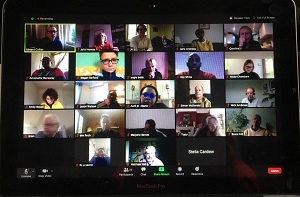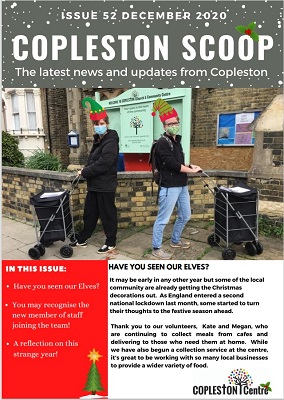 In the first of this month’s reflections, Church Related Community Worker Jo Patterson reminds us that as we embrace technology to reach out to people during lockdown, we must be careful not to exclude those who don’t have access to the internet.
In the first of this month’s reflections, Church Related Community Worker Jo Patterson reminds us that as we embrace technology to reach out to people during lockdown, we must be careful not to exclude those who don’t have access to the internet.
Jo, who is based at Copleston Church & Centre in Peckham, feels very grateful for the advances in technology which means many of us can connect and meet online, but is concerned that if we are not careful we will exclude those who do not have access to the internet or to adequate technology. It may seem arduous to create multiple forms of communication but it's essential that everyone has a voice and feels part of a community.
I’d like to have begun this reflection saying, ‘what a year 2020 was, now we can look back on it’. But sadly we are not quite there yet and we are still reinventing what we do on a regular basis. Our work here at Copleston has morphed into many things in the last 12 months – we have exercise classes on Zoom, Facebook worship, art classes online and counselling over the phone, Mutual Aid groups, meal delivery and collection for our older people and many other things. For some of us things have stood still and for others we’ve found new ways of being community and church.
 Hoping that lockdown restrictions would have eased by January, the church and community centre had arranged to meet for an away day. And all plans were scattered by the new guidance and an anxiety that we wanted to keep everyone safe and well.
Hoping that lockdown restrictions would have eased by January, the church and community centre had arranged to meet for an away day. And all plans were scattered by the new guidance and an anxiety that we wanted to keep everyone safe and well.
This work was the start of a new vision to investigate ways of blending the work of both groups, to find commonality in our missions and to work more closely together, in overarching vision and values but also in our necessary administration. It seems like a lot to do, but all big plans have to start somewhere. Just because we are in a lockdown doesn’t mean we have to stand still!
So we decided to press on and Zoom came to our rescue. In fact, we probably had more people attending because they didn’t have to travel, widening our reach to consult people from far and wide. The internet made this possible, we made great strides into finding our common aims, there was great energy and everyone met and worked with someone new.
There were Elders, church representatives, staff, church volunteers, trustees and clergy, from people in their 30s to someone in their 90s, with different reasons and motivations, all on a screen. And we now have a way forward, aim to meet again in a few weeks time and can see a way forward with a smaller focus group. This is relational working, building community despite the restrictions of physical social distance. In fact, it isn’t ‘social distance’ at all more a lack of physical presence.
But… a lot of our lives have become reliant on Zoom (other technological advances are available) and there are downsides. On a practical level, there are time limits – our away day was two hours. Sometimes there is no break between online sessions, often we dive straight into the next thing because we haven’t had to travel. There is fatigue at the end of a day when we have been sharing a screen for many hours. And the motivation to get ‘ready for work’ isn’t always there – who gets up and dressed ready for a work day at 9 am if they don’t need to?
Reaching those without internet access
Aren’t we fortunate to have access to the internet? But don’t we assume that everyone does? Half our congregation doesn’t so we  produce a hand delivered church newsletter to help us all keep in touch and bring our community together. Our Centre Newsletter ‘Scoop’ is still printed on paper and sent out with our food deliveries.
produce a hand delivered church newsletter to help us all keep in touch and bring our community together. Our Centre Newsletter ‘Scoop’ is still printed on paper and sent out with our food deliveries.
So there are variations in how we reach people and how we access things. And we have to be careful that we are not taking this even further: meaning that we don’t marginalise people because they don’t have internet access. Worship can’t be only online, community work only on Facebook and Instagram, meetings only on a screen.
This problem has been highlighted about our children’s education, but it is also about those who do not wish to have access or cannot afford to have access. In our joy at the beneficial use of technology are we inadvertently created a new excluded group? When working with those who live in economic poverty, broadband, smartphones and the like are often the first things to go. So, how do we make sure that everyone has equal opportunity to engage with their community and have a voice if we rely only on digital methods of communication?
Churches and communities will need to think a bit more about what we do. There are fantastic opportunities to be had if we continue to use technology allowing us to connect and reconnect with everyone, but we will need to make more effort when we talk about inclusion that we do not create a new group of the ‘technologically isolated’, ensuring we give the same opportunities to all.
Digital exclusion feeds inequality, so however difficult the task to replicate everything in various forms, we must make sure that we don’t just head down a route of digital resources and ensure we continue to support people regardless of access to technology. We shouldn’t make assumptions about access being about age, capability or poverty; it is also for some about choice.
Despite the benefits of technology and the wonderful progress we made at our Zoom meeting, analogue ways are still needed and expected to include everyone, especially at these necessary times of isolation and distance.
If you would like to know more about Church Related Community Work contact us as by email or telephone: 0207 916 2020. If you would like to know more about the Copleston Church and Centre, visit their page here.
First image created by Alex McCarthy on Unsplash.





